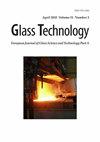有机玻璃顶棚红外反射涂层的研究
IF 0.5
4区 材料科学
Q4 MATERIALS SCIENCE, CERAMICS
Glass Technology-European Journal of Glass Science and Technology Part a
Pub Date : 2023-07-16
DOI:10.47672/ejt.1532
引用次数: 0
摘要
用途:太阳能是我们全球生态系统所必需的。在世界上的某些时间和地区,太阳产生的热量会让我们感到不舒服,我们需要使用额外的能量来冷却太阳产生的热量。由于产生空气污染和使用自然能源,这些额外的能源使用对我们的环境是有害的。本文的目的是研究利用反射涂层材料防止太阳产生不必要的热量。方法:本研究通过文献综述,从理论上研究了镓掺杂氧化锌(GZO)作为太阳能汽车有机玻璃顶棚的可见光透明和红外反射涂层材料。对掺杂浓度和薄膜厚度的影响进行了评述和讨论。铟锡氧化物(ITO)作为红外反射涂层材料,在可见光区是透明的,也进行了研究,利用各种文献综述。最后,利用分光光度计对有机玻璃、玻片玻璃和ITO镀膜玻璃的光学性能进行了测试,并对这三种材料的紫外和可见光透过率进行了测量。研究发现:GZO和ITO薄膜在太阳光谱可见区具有较高的透明度,对1500 nm至更高波长的红外辐射具有较高的反射率。这些薄膜都不能完全反射波长在700 nm到1500 nm之间的红外辐射,这是产生热量的主要原因。掺杂浓度和薄膜厚度等因素会影响薄膜的反射率,因为它们会影响等离子体频率的移动。增加GZO薄膜的掺杂浓度和厚度,直到达到一定的阈值,可以提高GZO薄膜的红外反射率,但在本研究中不可能精确地表达这些因素。减小纳米颗粒ITO薄膜的粒径可以提高薄膜在可见光区的透光率和在红外区的反射率。测量结果表明,有机玻璃和玻璃对可见光和近红外辐射具有较高的透明度。建议:建议进一步的研究和实验,以充分了解和制定GZO和ITO的掺杂浓度和膜厚度,在保持可见光透明度的同时,在700 ~ 1500nm波长范围内获得最佳的红外反射率。对于ITO涂层,建议减小纳米颗粒尺寸,以提高薄膜的可见光和红外透明度和反射率。虽然本研究尚不清楚GZO和ITO涂层的掺杂浓度和厚度如何才能达到700 ~ 1500 nm波长的红外反射率,但由于GZO和ITO涂层对1500 nm以上波长的红外反射率也有产热作用,因此为了减少热的产生,仍然推荐将其作为涂层材料。本文章由计算机程序翻译,如有差异,请以英文原文为准。
Investigation of IR Reflective Coating for Plexiglas Canopy
Purpose: Solar energy is necessary for our global ecosystem. In certain times and parts of the world, the heat generated from the energy of the Sun becomes uncomfortable for us and we need to use additional energy to cool down the generated heat from the Sun. This additional energy usage is detrimental to our environment due to generation of air pollution and use of our natural energy resources. The purpose of this paper is to investigate prevention of undesired generation of heat by the Sun using reflective coating materials.
Methodology: In this study, using literature review, Ga doped Zinc Oxide (GZO) is theoretically investigated as a visible light transparent and infrared reflective coating material for the Plexiglas canopy of a solar car. The effect of doping concentration and film thickness is reviewed and discussed. Indium Tin Oxide (ITO) is also studied, using various literature reviews, as an infrared reflective coating material that is transparent in the visible light region. Finally, a spectrophotometer was used to examine the optical properties of a Plexiglas, slide glass, and ITO coated glass, and the results of UV and visible light transmittance measurement of the three materials is presented and discussed.
Findings: GZO and ITO films both have high transparency in the visible region of the solar spectrum and high reflectivity to IR radiation starting from 1500 nm to higher wavelengths. None of these films completely reflect the IR radiation with wavelengths in the range of 700 nm to 1500 nm which contribute to generation of heat most. Many factors such as doping concentration and thickness of the films affect reflectivity of the films due to their effect on shifting the plasma frequency. Increasing doping concentration and thickness of the GZO films until a certain threshold improves IR reflectivity of GZO films, but it was not possible to precisely formulate these factors within this study. Reducing the particle size in nanoparticle ITO film improves transmittance of the film in the visible light region and its reflectance in the IR region. The measurement results showed that Plexiglas and glass have a high transparency to visible and near IR radiation.
Recommendations: Further investigation and experimentation is recommended to fully understand and formulate doping concentration and film thickness of GZO and ITO to achieve optimal IR reflectivity within the 700 to 1500 nm wavelength region while maintaining visible light transparency. In regards to ITO coating, reduced nanoparticle size is recommended to improve the desired visible and IR transparency and reflectivity of the film. Although GZO and ITO coatings’ doping concentration and thickness to achieve IR reflectivity within the 700 to 1500 nm wavelengths is not well understood in this study, to reduce heat generation they are still recommended as a coating material due to their reflectivity to IR with wavelengths of above 1500 nm which also play a role in generation of heat.
求助全文
通过发布文献求助,成功后即可免费获取论文全文。
去求助
来源期刊
CiteScore
0.30
自引率
0.00%
发文量
0
审稿时长
>12 weeks
期刊介绍:
The Journal of the Society of Glass Technology was published between 1917 and 1959. There were four or six issues per year depending on economic circumstances of the Society and the country. Each issue contains Proceedings, Transactions, Abstracts, News and Reviews, and Advertisements, all thesesections were numbered separately. The bound volumes collected these pages into separate sections, dropping the adverts. There is a list of Council members and Officers of the Society and earlier volumes also had lists of personal and company members.
JSGT was divided into Part A Glass Technology and Part B Physics and Chemistry of Glasses in 1960.

 求助内容:
求助内容: 应助结果提醒方式:
应助结果提醒方式:


